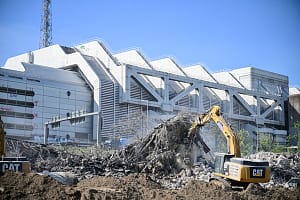Dust on site might seem harmless. But it’s not.
Every cut, drill or grind releases fine particles into the air. Most are invisible. All can be dangerous.
Construction dust is one of the biggest risks workers face. The effects often don’t show up straight away. That’s part of the problem. Someone breathes it in for years, then gets diagnosed later with something serious — lung disease, cancer, or permanent respiratory damage.
For site owners and health and safety leads, managing dust exposure isn’t optional. It’s a legal duty. It’s also the difference between a safe workplace and one that slowly puts people at risk.
This article looks at where dust comes from, what it does to the body, and how to reduce the risks before long-term harm takes hold.
1. Types of construction dust and where it comes from
Not all dust is the same. Some of it is a mild irritant. Some of it is deadly.
Silica dust is a key concern. It’s produced when cutting bricks, concrete, and stone. Even short-term exposure, without controls, can lead to serious health issues. Wood dust, particularly from hardwoods or MDF, also poses a high risk. Other materials, including plasterboard, cement and insulation, generate fine particles that are harmful when inhaled.
Then there’s asbestos. It’s not on every site, but when it is, especially in older buildings, the risks are significant. Asbestos fibres don’t just irritate. They embed in the lungs and can lead to cancer. Once disturbed, they can spread well beyond the original area.
The problem is that asbestos doesn’t look dangerous. It’s often hidden in ceiling tiles, pipe lagging, insulation boards and floor panels. Spotting it isn’t easy without the right awareness.
An online asbestos awareness training course helps workers and site managers understand where asbestos might be, how to identify risk factors, and when to stop work. It’s not about removal — that’s for licensed professionals. But it’s about recognising when something needs further assessment.
Even where asbestos isn’t present, routine construction work generates harmful dust daily. The longer people breathe it in, the more serious the consequences become.
2. Health risks from dust exposure
Unlike a fall or a cut, dust doesn’t cause instant pain. It builds up quietly, over months and years. That’s what makes it so dangerous.
Short-term effects might be limited to coughing or eye irritation. But over time, chronic exposure can lead to serious illness, including silicosis, chronic obstructive pulmonary disease (COPD), lung cancer and occupational asthma. These conditions can be irreversible and life-limiting.
Many workers only realise something is wrong once symptoms are advanced. And by that time, it’s often too late to undo the damage.
Young workers aren’t immune. In fact, they may be more vulnerable. They might ignore safety advice, assume they’re fine, or use the wrong protection. But the consequences still follow, just further down the line.
Masks help, but only if they’re the right type, worn properly and maintained correctly. Even the best PPE won’t protect if it’s used inconsistently or treated as an afterthought.
That’s why it’s essential to manage dust at its source. Water suppression, local extraction, and ventilation should be built into every job. Awareness, reinforced daily, is what makes these controls work in practice.
3. Legal duties for construction site operators
The Control of Substances Hazardous to Health (COSHH) Regulations 2002 require employers to assess, control and review exposure to hazardous substances. That includes construction dust. Sites must identify where risks exist, decide on control measures, and prove that those measures are working.
It’s not enough to make a general effort. The law expects a structured approach — starting with written risk assessments, control strategies, and documented reviews.
Employers must also provide suitable training. Workers should know what substances they are exposed to, how to protect themselves, and how to use equipment properly.
The Health and Safety Executive (HSE) conducts regular site inspections. Failure to manage dust can lead to improvement notices, prohibition orders, or prosecution. In serious cases, it can result in substantial fines or criminal liability.
Legal compliance also means routine maintenance, housekeeping, and visible commitment to dust control. It’s not something to sort out later — it must be part of how work is planned and delivered every day.
4. Improving site-wide awareness and behaviour
Policies alone don’t control dust. People do.
Effective dust management depends on worker behaviour. That means encouraging teams to speak up about issues, report broken equipment, and challenge unsafe practices.
Start with clear communication. Toolbox talks, signage, and visible leadership help reinforce the message. Make dust protection as normal as wearing gloves or high-visibility clothing.
Small decisions make a big difference. Choosing to cut outside instead of inside. Using an extractor instead of brushing down. Picking up a vacuum instead of dry sweeping. These habits, repeated daily, reduce exposure significantly.
But people need to understand why. It’s not enough to hand out instructions — training must connect the task to the risk. If workers understand what’s at stake, they’re more likely to follow the right steps.
Dust control must become part of the culture. Not just a policy on paper, but a shared standard across the site.
5. Training that sticks: Helping workers take dust seriously
Many workers are focused on getting the job done. If a task seems minor or quick, safety steps are often skipped. That’s not due to carelessness — it’s habit, pressure and lack of understanding.
That’s why training must go further than a checklist. It must help people recognise what dust does to the body and how it builds up over time.
Online health and safety training can be provided to help workers understand the core risks they are likely to face and how to respond appropriately. Safety courses for construction can cover common causes of site accidents, such as falls, collisions, and equipment misuse, and how injuries can result from everyday tasks like poor manual handling or working around hazardous substances.
6. Monitoring and reviewing dust controls on site
Plans only work when they’re followed.
As work progresses, conditions change. Tools are swapped, teams move around, weather affects ventilation. That’s why regular monitoring is essential.
Site managers should walk the site often. Watch how tools are being used. Listen to workers. Ask if the extraction is working, if the dust levels feel excessive, or if the PPE fits properly.
Documenting these checks helps. A simple log, updated weekly, builds a record of action. If something goes wrong, it shows that risks were being taken seriously.
Controls also need to be realistic. If equipment is hard to access or awkward to use, staff may avoid it. Practical solutions, designed around real site work, will always be more effective.
Involving the team helps too. Workers know where the problems are. If they’re included in reviews, they’re more likely to stay engaged and suggest better solutions.
Wrapping up
Construction dust doesn’t make noise. It doesn’t trip alarms. But it causes serious, long-lasting harm if left unmanaged. That’s why it deserves daily attention.
From brick cutting to drilling, every dusty task carries a risk. And every missed step increases exposure, not just for the person doing the job, but for those around them too.
The good news is, it’s preventable. With the right planning, clear training, and practical controls, site teams can reduce exposure and protect their health for the long term.
Real safety isn’t complicated. It’s consistent. It comes from habits, leadership and systems that treat dust control as essential, not optional.
Because what’s in the air today decides how healthy workers are tomorrow.






Leave a Comment